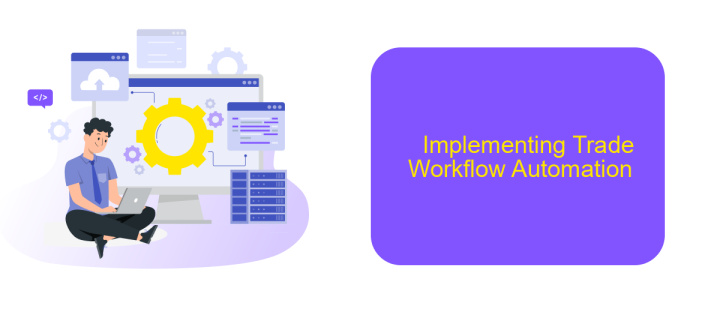Trade Workflow Automation
In today's fast-paced financial markets, trade workflow automation has become essential for enhancing efficiency and accuracy. By leveraging advanced technologies, firms can streamline trading processes, reduce manual errors, and ensure compliance with regulatory standards. This article explores the key benefits and implementation strategies of trade workflow automation, providing insights into how it is revolutionizing the trading landscape.
Introduction
Trade workflow automation is a transformative approach that leverages technology to streamline and optimize the various processes involved in trading. By automating repetitive tasks and integrating different systems, businesses can significantly enhance their efficiency and accuracy, leading to improved decision-making and reduced operational costs.
- Increased efficiency and productivity
- Reduced human error and operational risks
- Enhanced data accuracy and real-time insights
- Seamless integration of various trading platforms and tools
One of the key tools in trade workflow automation is ApiX-Drive, a service that facilitates the integration of multiple systems without the need for coding. By using ApiX-Drive, businesses can easily connect their trading platforms, CRM systems, and other essential tools, ensuring a smooth and efficient workflow. This not only saves time but also allows traders to focus on more strategic tasks, thereby driving better business outcomes.
Benefits of Trade Workflow Automation

Trade workflow automation streamlines various processes, reducing the time and effort required to manage trading activities. By automating repetitive tasks, businesses can minimize human error and increase efficiency. This leads to faster transaction times and improved accuracy, which are crucial for staying competitive in today's fast-paced market. Automation also allows for better resource allocation, enabling teams to focus on strategic initiatives rather than mundane tasks.
Moreover, integrating various systems through platforms like ApiX-Drive can further enhance the benefits of trade workflow automation. ApiX-Drive simplifies the process of connecting different software solutions, ensuring seamless data flow and real-time updates. This integration capability not only boosts operational efficiency but also provides valuable insights through comprehensive data analysis. As a result, businesses can make more informed decisions, optimize their trading strategies, and ultimately achieve better financial outcomes.
Components of a Trade Workflow Automation System

Trade Workflow Automation is essential for streamlining and optimizing trading processes. A comprehensive system typically consists of several key components that work together to ensure efficiency and accuracy.
- Order Management System (OMS): This component handles the placement, tracking, and execution of trade orders, ensuring that they are processed in a timely and accurate manner.
- Risk Management Tools: These tools monitor and manage the risk associated with trades, helping to mitigate potential losses and ensure compliance with regulatory requirements.
- Data Integration and API Management: Services like ApiX-Drive facilitate seamless integration between various platforms and data sources, ensuring that all relevant information is accessible and up-to-date.
- Reporting and Analytics: This component provides insights into trading performance, helping users to make informed decisions and optimize their strategies.
- Compliance and Regulatory Reporting: Ensures that all trading activities adhere to legal and regulatory standards, reducing the risk of fines and penalties.
By incorporating these components, a Trade Workflow Automation System can significantly enhance the efficiency, accuracy, and compliance of trading operations, ultimately leading to better performance and reduced operational costs.
Implementing Trade Workflow Automation

Implementing trade workflow automation involves streamlining and optimizing various trading processes to enhance efficiency and reduce manual intervention. The first step is to assess the current workflow and identify areas that can benefit from automation. This involves understanding the trading cycle, from order placement to execution and settlement.
Once the assessment is complete, the next step is to select the appropriate automation tools and platforms. One such tool is ApiX-Drive, which facilitates seamless integration between different trading systems and platforms. ApiX-Drive allows for the automation of data transfer, ensuring that information flows smoothly between various applications without manual input.
- Identify key processes for automation.
- Select suitable automation tools like ApiX-Drive.
- Integrate trading systems and platforms.
- Test and monitor the automated workflow.
After implementing the automation, it is crucial to continuously monitor and refine the workflow to adapt to changing market conditions and technological advancements. Regular updates and maintenance of the automation tools ensure that the trading processes remain efficient and effective.


Conclusion
Trade workflow automation represents a significant advancement in optimizing and streamlining trading processes. By leveraging technology, businesses can enhance efficiency, reduce operational costs, and minimize human errors. Automation tools and platforms enable seamless integration of various trading activities, from order management to settlement, ensuring a smooth and efficient workflow. This technological shift not only accelerates transaction times but also provides real-time insights and analytics, empowering traders to make informed decisions promptly.
Moreover, services like ApiX-Drive play a crucial role in facilitating these integrations. ApiX-Drive offers a user-friendly interface that allows businesses to connect different trading systems and automate data transfer effortlessly. By simplifying the integration process, ApiX-Drive helps firms to maintain a cohesive trading environment, ensuring that all systems work in harmony. As the trading landscape continues to evolve, embracing automation and leveraging integration services will be essential for staying competitive and achieving long-term success.
FAQ
What is Trade Workflow Automation?
How can Trade Workflow Automation benefit my business?
What types of processes can be automated in trade workflows?
How do I integrate Trade Workflow Automation into my existing systems?
Is it difficult to set up Trade Workflow Automation?
Do you want to achieve your goals in business, career and life faster and better? Do it with ApiX-Drive – a tool that will remove a significant part of the routine from workflows and free up additional time to achieve your goals. Test the capabilities of Apix-Drive for free – see for yourself the effectiveness of the tool.

